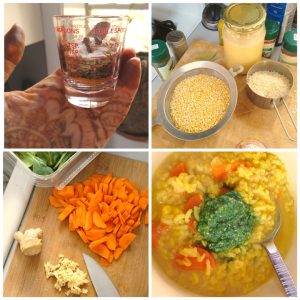While staying at the Yoga Institute in Mumbai during my first trip to India some time ago, we were served a yellow, mushy cooked food at every one of our meals. I had no idea what it was – all I knew was that it was totally delicious. This began my love affair with kitchari!
Kitchari means “food of the gods” in Sanskrit. This hearty, one-pot dish is widely eaten in India, especially by sadhus, who leave it to cook while they are meditating. It’s also served in India’s hospitals to children and the elderly since it’s an easy-to-digest nourishment. Therefore this recipe is great for anyone who is recovering from an illness, fatigue, or having digestive problems. It’s excellent for general detox at the change of season (spring and fall). Prized as a nourishing and cleansing complete meal in Ayurveda, it has been a staple in my diet when I’m sick, cleansing (a 1-3 day kitchari cleanse is incredible), or needing to give my system some serious comfort. Bonus – the house smells incredible after cooking it!
Healing Kitchari Recipe

I came home from India and whipped up kitchari first thing. You can still see the beautiful henna design still on my hand!
Ingredients:
-
1 cup split yellow mung dal
-
1 cup long-grain white basmati rice
-
1 Tbsp ghee
-
1 Tbsp fresh minced ginger
-
1 tsp each: black mustard seeds, cumin seeds, turmeric
-
½ tsp each: coriander, fennel seeds, sea salt
-
3 cloves
-
3 bay leaves
-
1-inch piece kombu (optional)
-
6 cups filtered water and/or broth of your choice (I do a bit of both)
-
1–2 cups chopped veggies (optional — carrots, zucchini, spinach work great)
Directions:
-
Rinse mung dal and rice thoroughly.
-
In a large pot, melt ghee over medium-low heat. Sauté mustard seeds, cumin, ginger, fennel, coriander, and cloves for 1–2 minutes, until fragrant.
-
Stir in the rice and dal; sauté for 2–3 minutes.
-
Add turmeric, bay leaves, kombu, and water. Bring to a boil.
-
Lower heat, cover, and simmer for 30–45 minutes, until soft and stew-like.
-
Add veggies during cooking: harder veggies early, greens toward the end.
-
Adjust salt to taste. Add more water or broth if needed.
Serve warm, topped with fresh cilantro or a spoonful of cilantro chutney (recipe below). Slow down, savor, and enjoy this healing comfort food.
Cilantro Chutney Recipe
Ingredients:
-
1 bunch fresh cilantro
-
¼ cup lemon juice
-
¼ cup filtered water
-
¼ cup shredded coconut
-
2 Tbsp fresh ginger
-
1 tsp raw honey
-
1 tsp sea salt
Directions:
Blend everything into a thick paste using a blender or small food processor.
Add a spoonful on top of kitchari or any meal that needs a fresh, zesty kick.
Keeps in the fridge for up to a week.
Benefits of Kitchari:
Kitchari is a nourishing, healing meal that builds strength and vitality. It’s a powerful blood purifier and, in Traditional Chinese Medicine, mung beans are known for drawing out environmental toxins—especially beneficial for the reproductive organs, liver, and thyroid.
Made from rice and mung beans, kitchari is a complete plant-based protein, providing all ten essential amino acids. While most plant foods need to be combined to form a complete protein, this comforting dish does it all—satisfying and supportive for any diet.
In India, kitchari is often a baby’s first food for its ease of digestion and gut-healing qualities. It’s also a favorite of monks and yogis, promoting stillness, calm, and clarity for spiritual practice.
Make kitchari when you’re feeling under the weather, low on energy, returning from travel, cleansing, or simply in need of deep comfort. It’s food for healing—body, mind, and soul.
